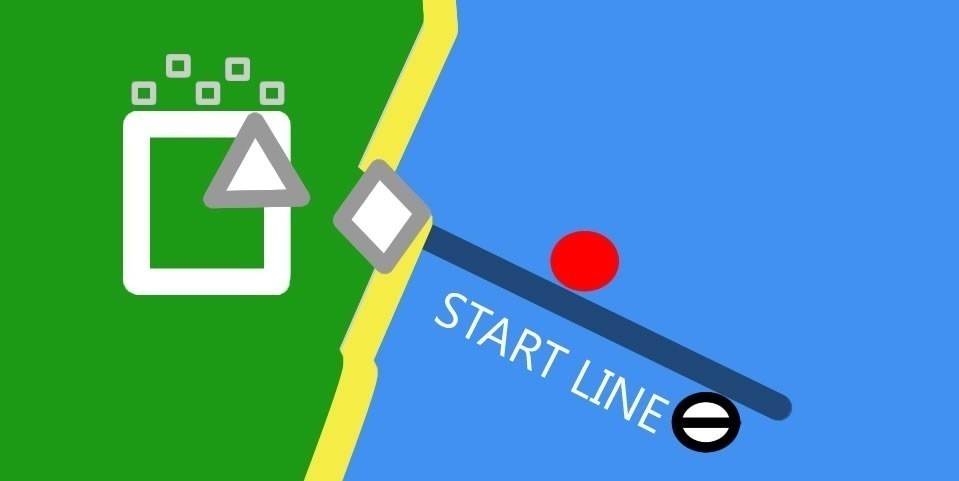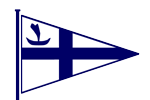Course notes - practice and lesson

Start line Day 1
Before the start
- Look at the forecast and the tide tables
- Try to get to the club as early as possible so as not to rush
- Take a good look at the course, making note of the start buoys, direction of rounding and number of laps
- Try to understand what point of sail you are on at least to the first mark
Start sequence
5 minute, 4 minute, 1 minute, start
If you hear a second horn after the start, somebody is over the line. A flag will stay down until all OCS boats have gone back behind the line.
There is also a 10 minute signal / light. Far left hand light and flashing orange light.
More details about start lights are on this page.
Start line
The start line is a transit of the triangle on the race box and the diamond to the south of the car park. The start buoys may or may not be on this line. Generally you must start between the two buoys – the inner mark is red, the outer mark is white and black. Watch the course blackboard as the start buoys may be different.
Start procedure
Get out on the water in plenty of time to take a look at the course.
- Go to the outer mark and look back at the transit to see where it is relative to the two start buoys
- Look at the water on the buoy to see which way the tide is flowing
- Do at least one practice start
- If you have time go as far as the first tack
- Try to work out which end is favoured
- Try to work out what tack you need to be on – preferably starboard
- Head back to where you want to make your start from – to the right of the starboard lay-line for the right hand (usually inner) mark – 2 or 3 minutes before the start
- You should be in a position so that you can make the line without tacking
- Gybe round onto starboard and approach the start at an angle to the wind so that you can slow down by easing the sail
- Avoid pointing the boat higher than close hauled – it will be harder to accelerate out of and you could get stuck in irons
- Try to avoid the right hand buoy unless there is nobody to your left – to leeward. They can push you “up”, the wrong side of the buoy
- Do not go to the left of the starboard lay-line for the left hand (usually outer) mark. You will have to tack to get back through the line
- Be aware of the tide. If it is with you, you will struggle to slow the boat down so start your run up to the line later. If it is against you, it is very easy to stop your boat so you can start your run up closer to the start
- Keep looking at your watch and synchronise it at 4 minutes and 1 minute
- Aim to be as close to the line when the horn sounds as possible, travelling as fast as possible
- If you hear the OCS horn and you think it is you, go back through the line until all of your boat is behind the line
Getting to the first mark
If you are unable to fetch the first mark without tacking then you need to choose a safe and fast place to tack.
You are likely to have started on starboard in which case everything is safe for you. Everybody is heading in the same direction and if they aren’t then you have right of way over them. If somebody is approaching you on port, look at their eyes and make sure they have seen you, if not shout “starboard”.
When you come to tack you must be completely aware of everybody over your left shoulder. If there is a boat behind you but to windward, it is likely that you will be unable to tack until they do. Don’t panic, they will have to tack eventually.
DO NOT TACK WITHOUT LOOKING
If you are in a position to tack make sure your traveller is in towards the middle and the main is pulled in. Ease the main a fraction as you go through the tack. Sit forward and drive the boat on.
You are now on port tack, you must be constantly vigilant about boats coming at you on starboard. If you are on collision-course you must decide how to avoid them.
- If you are confident you can cross in front of them without causing them to change course keep going
- If you cannot get in front of them either:
- Let the traveller and main out and duck behind them or
- Tack back onto starboard
- Let the traveller and main out and duck behind them or
- If you have messed up and you cannot avoid them, ram the stick away from you to push yourself into irons; at the very least the collision will be less serious and they may be able to avoid you anyway
You should aim to get onto the starboard lay-line a distance away from the buoy, but not so far that you are on the beach. If you come onto the buoy on port tack then you have no right of way.
Pay attention to the tide when choosing where the lay-line is. If the tide is against you, you need to go further.
Day 2
The rest of the course
As you round the first mark, you are likely to be bearing away. Try to work out whether you need to gybe or not before you get there.
You can uncleat the traveller before the buoy and hold it in by not releasing the main sheet.
Ease the main as you go round the buoy if you are going onto a run.
If you are on a reach then keep looking at your tell-tails and adjusting the sail, as you go faster, the apparent wind goes further ahead and you need to sheet in more.
Downwind: try to keep your burgee pointing at the windward stern of the boat, if your wind indicator is spinning then you are sailing too low.
Be just as aware of port and starboard boats crossing each other downwind. You need to keep looking over your shoulder to see where other boats are.
Keep anticipating what to do before you reach each mark and adjust the downhaul and traveller early if appropriate.
You must go inside the outer mark each lap, you do not need to go outside of the inner mark.
Rules
- Starboard has right of way over port
- Windward boat stands clear – you cannot bear away onto another boat
- Overtaking boat stands clear – if you want to overtake another boat you should do so to leeward or well to windward
- Outside boat at a mark must give room to an inside boat but only if they were overlapped at the 3 boat length “zone”. The inside boat should call “water” if he thinks he has an overlap. If an overlap is created before or after the 3 boat length zone, it does not effect the right of way.
- Starboard does not have right of way inside the 3 boat length zone of a downwind mark
Sailing fast
Balance the boat
- Sit forward and towards the middle of the boat in light winds
- Lean out and sit further back as the wind builds
- Sit by the shrouds going to windward in F3 or higher
- Sit right back when reaching in F5 or higher
Sail trim
- Constantly look at your tell-tails when going into or across the wind
- Never let the leeward tell-tails drop when going to windward
- Aim to get the top windward tell-tails flying most of the time
- Spill excess power when going to windward by easing the traveller
- In light winds going to windward have the traveller in and the main eased slightly
- If you have arms on your wind indicator, point them at the front of the beams and line them up with the moving arms to get the optimum pointing angle
Don’t capsize
- Only cleat the main when tacking so you can dump the power in a gust
- Push the stick away from you if a gust hits you
- If you see a gust coming get ready to lean out hard



